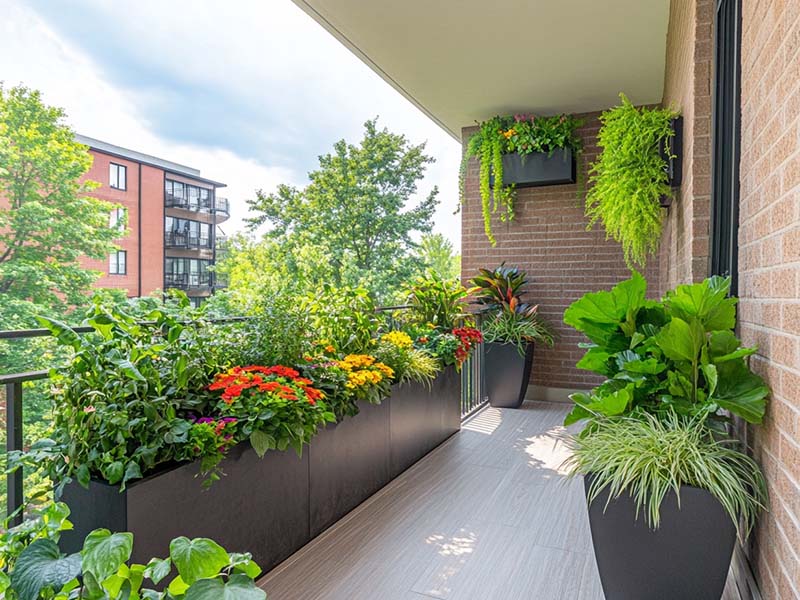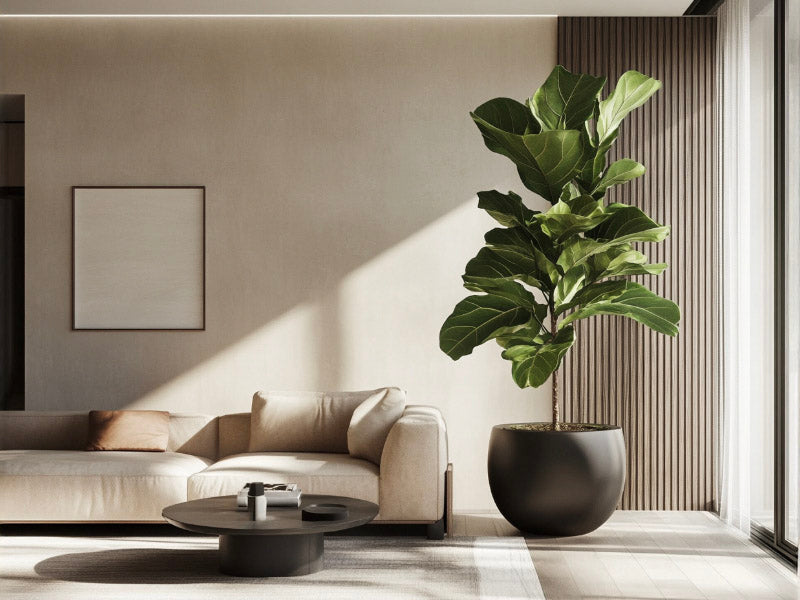Rooftop gardens, usually referred to as "green roofs", offer numerous advantages and just a few downsides to take into account. You would assume that a structure covered with a covering of plants is called a "green roof" because of the vegetation; but in reality, it stems from all the positive environmental effects that creating a roof garden has both on you and the world around you.
Generally speaking, any plant you grow on your roof should be somewhat resistant to sun exposure and drought. A roof often receives a lot of sunlight, so unless you have some shelter, you'll need to choose plants that can withstand a lot of exposure to the sun.
Read on to learn about the best 19 roof garden plants and pick one to bring your terrace garden to life!
Find the perfect plant pots for your roof garden plants with our collection of stylish and functional Fiberglass Planters before jumping in!
8 Best Herbs, Fruit And Vegetables For A Terrace Garden
For rooftop gardening, all you need are large containers or raised beds, optimum exposure to sunlight, and water, slightly acidic and healthy soil, and adequate drainage to start your own vegetable garden.
If you are worried about how the elements will affect your plant pots, learn how to maintain your planters with this guide!
Vegetables require more care than herbs, so if you're growing them for the first time, start with these veggies:
1. Strawberries (Fragaria ananassa)
Fragaria ananassa, or strawberries, require rich, organic soil. Manure and compost are excellent fertilizers to use. They produce exquisite white blooms and have oval, serrated leaves that grow in groups of three.
Since they don't need to be replanted each year, they are quite hardy garden plants.
Top tip: In order to prevent birds from eating the strawberries themselves, you'll need to make sure your garden bed has some deterrent-like netting.
2. Cherry Tomatoes (Solanum lycopersicum)
If you like tomatoes, the cherry tomato (Solanum lycopersicum var. cerasiforme) is ideal for your rooftop. They grow numerous tiny tomatoes that, like conventional, bigger tomatoes, may be eaten whole or sliced up and used on sandwiches and soups.
They are somewhat sweeter than larger tomatoes and may be planted in standard potting soil.
Top tip: These are full sun plants, so position them in a location where they will get enough light.
3. Blueberries (Cyanococcus)
Blueberries require soil with a higher acidity that drains effectively while keeping the root system wet, especially for newly planted plants. The berries themselves are lovely, and the bushes on which they grow are ideal for landscaping.
Top tip: Plant them in the fall or spring, and be sure to put them in a location where they will get plenty of sunlight.
4. Bell Peppers
Bell peppers (part of the Capsicum annum family) are an excellent rooftop plant since they require full light to produce peppers. This plant thrives in sandy, well-draining soil, which protects it from root rot.
Top tip: Plant them early in the season, as they might take a long time to produce the huge peppers you need.
5. Cucumber (Cucumis sativus)
If you're concerned about your ability to grow vegetables due to your lack of experience, growing a cucumber garden may be ideal for you! They require very low maintenance as long as they have plenty of sunlight and water. If you let them grow vertically, their vines will take up far less horizontal space, making room for other plants.
Not sure how to fill, the water. and install your plant pots? Read our guide to installing planters!
6. Bush string beans (Phaseolus vulgaris)
There are many different bean kinds (Phaseolus vulgaris), including bush variants and types that thrive when planted next to a pole so they may shoot vines up it.
Beans are an excellent source of nutrition and a wonderful addition to your rooftop garden. Plant them in well-drained soil, in full sun.
Top tip: Beans may also be used to replenish soil nitrogen, which is critical for plant growth.
7. Lavender (Lavandula angustifolia)
Lavender, a beloved fragrant plant that is a native of the Mediterranean and a member of the mint family, thrives in the windy, dry conditions of a rooftop garden.
Because of its lovely, gray-green leaves, which grow to a height of approximately a foot and a half, it works well in both containers and full-fledged rooftop garden beds.
8. Rosemary (Salvia rosmarinus)
Another herb with a variety of uses in the kitchen is rosemary (Salvia rosmarinus), which also has a nice look and texture. Although its leaves are not as spiky as pine needles, they more nearly resemble those on pine trees. They may also be used as decorations since they bloom.
Top tip: Rosemary thrives in loamy soil, but with periodic fertilization, it can also tolerate poor soil.
11 Best Decorative Plants For A Balcony Garden
1. Roses
Because of their wide range of colors and the elegance of their blossoms, roses (Rosa) are a traditional plant that many people grow in their gardens, flowerbeds, and yards.
Top tip: for the most abundant flowers, plant them in full sun and deep, well-draining soil.
2. Juniper
Depending on how it is trimmed or the particular type you buy, a juniper (Juniperus) can be either a tree or a shrub. They often stand out among other plants you can have in your rooftop garden because of their light grey-green hue.
Top tip: the optimum soil for juniper plants is rich soil that drains properly. Be careful not to put it where there is standing water because this can cause the plant to develop root rot.
3. Coreopsis
Beautiful Coreopsis (Coreopsis) flowers are sold in a variety of hues, occasionally more than one.
They are a particularly drought-tolerant plant, making them an excellent bloom for those of you who struggle to remember to water your garden.
Top tip: These plants don't care too much about the type of soil you grow them in as long as it doesn't retain too much moisture.
4. Succulents
Succulents come in a wide variety, but one of the most resilient and easiest to grow in a sunny rooftop garden is the Hen and Chicks (Echeveria exquisite), often known as the Snow Rose.
It is simple to transplant and spreads by subterranean runners. They don't care about the type of soil, and they can thrive in areas where many other plants can't. However, keep in mind that because they are a succulent, too much water won't be good for them.
Top tip: The easiest rooftop gardening plants to care for are Cactus and Aloe Vera, which are also the most common and accessible.
5. Marigolds
Tagetes, or Marigolds, are stunning, often colorful flowers. They have rather small flowers and are frequently used by rooftop gardeners to deter pests.
Although they are an annual bloom, the seeds they produce allow them to come back the next year without needing to be replanted. Put marigolds in rich, well-draining soil.
Top tip: If you're planting in rows, leave eight to twelve inches between each one.
6. Kousa dogwood
Kousa dogwood (Cornus kousa) is a small tree that grows to around 30 feet in height, making it a suitable foundation planting for a rooftop garden.
The tree features little but lovely white-to-pink blooms in the spring, which convert to rich green leaves in the summer. Autumn has its own set of advantages, with its red-purple foliage and berries (which start to appear in August).
7. Dwarf Hinoki Cypress
The golden dwarf hinoki cypress (Chamaecyparis obtusa 'Nana Lutea') has fan-like foliage with a yellowish-green tint. These plants grow quite slowly and mature at just 3 feet tall. These dwarf trees require frequent watering but are generally very low maintenance.
The golden dwarf Hinoki Cypress will brighten the corners of a rooftop garden or pair well with other plants in container combinations.
One of the best combinations for Hinoki Cypress is the Cuba low corner planter. Available in the size of 14 x 14 x 12, these containers will not only bring life to the empty corners but also save you tons of space as well!
Simply contact us for more details on the Cuba low corner planter!
8. 'Big Daddy' Hosta
A great technique to enhance the beauty of the leaves in a rooftop garden is to incorporate impressively big hosta into the shadier areas.
One option is the Hosta 'Big Daddy', its blue-green leaves offer deep, rich color and are large enough to cut as foliage for bouquets, making it ideal for multipurpose rooftop gardening plants.
9. Lamb's Ears (Stachys byzantine)
Stachys byzantina, sometimes known as lamb's ears, is a lovely choice for low-growing borders or the front of flower beds because of its very delicate, feathery-feeling silver-gray leaf. Cut back the purple blossoms if they become overgrown in the summer. This plant is perfect for raised beds or containers on rooftop gardens because it spreads easily in the ground.
If you are not sure how to choose the best container size for your plants, check out this article on Best Plant Pot Sizes | Guide & Planter Size Chart.
10. Japanese Wisteria
Showy wisteria is a popular woody vine with fragrant blooms that resemble grapes. Wisteria 'Blue Moon' offers even more with three bloom periods during the growing season, its wandering vines provide an excellent accent over a rooftop garden trellis or pergola.
Take note that Wisteria may be invasive in some regions; verify local laws before growing it.
Top tip: Parts of this plant are also toxic so keep away from children and animals.
11. Blue Fescue (Festuca glauca)
Ornamental grasses are ideal for rooftop gardens because they are durable, need little maintenance, and provide a year-round structure. Blue fescue (Festuca glauca) may be used in containers, as a border, or as an edging plant. Blue fescue is a hardy plant and grows to a height of 10 inches.
To perfectly complement Blue fescue, use large containers in rectangular shapes to create borders or privacy. Take the Miami rectangular planter for inspiration, available in 20 colors and 5 sizes, this rectangular container can bring any outdoor space to perfection!
Related article: 11 Modish Rooftop Garden Ideas For Every Home
FAQs About Roof Garden Plants
Are roof gardens a good idea?
Rooftop gardens are lovely complements to urban environments. These gardens benefit the environment by collecting CO2 and creating breathing oxygen. They also promote urban gardening, with fresh veggies and herbs produced directly in their own backyard.
What are the critical elements of a rooftop garden?
Roof gardens are typically made up of bigger containers filled with a variety of evergreens, flowers, shrubs, and grasses. A roof garden can be seen as an outdoor room if it includes outdoor furniture.
For limited terrace spaces, using a variety of plants in rectangular planters, especially bigger ones, is a fantastic idea. If there are multiples of the same plant or a diversity of plants that complement each other in the overall design scheme, the number of containers utilized in a space can be minimized.
Check out these 6 Amazing Rectangle Planter Ideas To Liven Up Your Property.
How do I build a cheap roof garden?
Because city dwellers live in close quarters, the roof garden is a treat for them. These allow one to extend the length and have an artistic turf. You may have begun to think about the cost. Don't be scared! A roof garden may be built at a reasonable cost. Read on to find out how:
- Understand regional legislation: Before you start building a roof garden, learn about the local regulations. Perhaps it is illegal in the region, or you may require a permit.
- Choose the plants wisely: Consider the amount of sunlight your rooftop receives (tomatoes, for example, require a lot of sunlight every day) and the thickness of your planters (root veggies such as carrots and radishes need a great deal of deep soil to cultivate). Certain plant varieties may benefit from breeze and humidity. In general, herbs, peas, beans, kale, spinach, and lettuce thrive well in many rooftop gardens.
- Invest wisely in your planter: When it comes to roof gardening, planter material that is durable, lightweight, and able to withstand all weather conditions is a must. The last thing you want to do is to waste money on planters every year. An ideal solution for this issue is fiberglass containers, not only because they can take on any terrace garden challenges but also because of their flexibility in design!
Learn more about how our fiberglass planters are made and how they benefit you!
Put The Finishing Touch To Your Rooftop With Our Fiberglass Planters Collection
Our fiberglass planters are designed for rooftop gardening challenges. They're lightweight, weatherproof, and durable, making them ideal for rooftop environments. You won't have to worry about frequent replacements or maintenance.
With a wide range of sizes, shapes, and colors to choose from, you can customize your rooftop garden with ease. Create a thriving urban oasis that's not only visually stunning but also eco-friendly.
Don’t let challenges hold you back! Experience perfection in every planter from JBD Concepts, designed to transform any space. Secure your investment with a 3-year warranty. Explore our Fiberglass Planters Collection today and revamp your rooftop!























